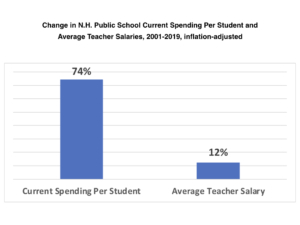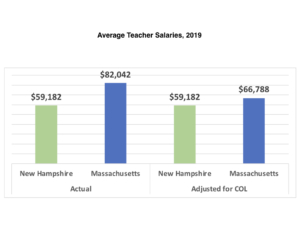Teacher pay in NH lags the national average despite $1 billion in new spending
Teachers unions and school officials regularly advocate for higher public school spending on the argument that teacher pay is too low. In fact, teacher pay in New Hampshire is relatively low compared to other states. But that’s not a product of low funding levels.
Average public school district spending in the Granite State is is 14.4% above the national average, while our teacher pay is 5.3% below the national average.
What explains that discrepancy? School districts have used huge increases in funding this century primarily to hire new personnel, particularly administrators and support staff, rather than raise teacher pay, even as enrollment sharply declined.
Our new public school spending study found that real (inflation-adjusted) spending on public school districts rose by $937 million, or 40%, from 2001-2019. Student enrollment fell by 14%, or 29,946 students, during this same time.
On a per-pupil basis, current spending, which excludes debt service and capital expenditures, grew by 74% from 2001-2019, but teacher pay rose by only 12%.

In 2021 (the most recent data available allowing for national comparison), teacher salaries in New Hampshire averaged $59,182 per year, while the national average was 5.3 percent higher at $62,304 per year.
The cost of living in New Hampshire is estimated to be 9.9 percent higher than the national average, which makes the lower teacher salaries in New Hampshire even more noteworthy.
Teacher pay is significantly higher in Massachusetts, even after adjusting for cost of living. Since they do not have as much staffing, Massachusetts public schools are able to pay their teachers higher salaries.
The raw difference is $82,042 in the Bay State vs. $59,182 in New Hampshire. Taking into account the cost of living, Massachusetts teachers are paid $7,606 more on average than New Hampshire teachers, a difference of almost 13 percent.

Massachusetts public schools spend their monies very differently than New Hampshire public schools do. New Hampshire public schools have more staffing. New Hampshire public schools have 18.2 full-time equivalent (FTE) staff per 100 students vs. 13.9 per 100 students in Massachusetts public schools. For a school of 500 students, New Hampshire would have about 21.5 more FTE staff than a school of the same size in the Bay State.
Comparing New Hampshire to the national average, a 500-student school in the Granite State would have 26 more FTE staff, 14 more special needs students, 38 fewer English language learner students and 50 fewer students in poverty than the average school nationwide.

The low teacher pay in New Hampshire relative to the national average is not a result of low spending. Taxpayers have spent $937 million more on public school districts since 2001 above the level needed to keep up with inflation. Spending per-pupil in New Hampshire public school districts was $2,383 (14.4 percent) above the national average in 2019.
Rather, districts have chosen to focus on hiring, even as enrollment has fallen. As a result, average public school district employment levels are well above the national average while teacher compensation is below the national average.
If this discrepancy persists, it will become increasingly challenging for New Hampshire districts to recruit high-quality teachers even as declining enrollments reduce the demand for new teaching positions.



